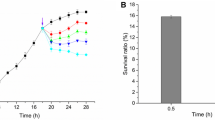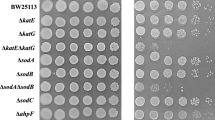Abstract
Solvent stress occurs during whole-cell biocatalysis of organic chemicals. Organic substrates and/or products may accumulate in the cellular membranes of whole cells, causing structural destabilization of the membranes, which leads to disturbances in cellular carbon and energy metabolism. Here, we investigate the effect of cyclohexanone on carbon metabolism in Escherichia coli BL21 and Corynebacterium glutamicum ATCC13032. Adding cyclohexanone to the culture medium (i.e., glucose mineral medium) resulted in a decreased specific growth rate and increased cellular maintenance energy in both strains of bacteria. Notably, carbon metabolism, which is mainly involved to increase cellular maintenance energy, was very different between the bacteria. Carbon flux into the acetic acid fermentation pathway was dominantly enhanced in E. coli, whereas the TCA cycle appeared to be activated in C. glutamicum. In fact, carbon flux into the TCA cycle in E. coli appeared to be reduced with increasing amounts of cyclohexanone in the culture medium. Metabolic engineering of E. coli cells to maintain or improve TCA cycle activity and, presumably, that of the electron transport chain, which are involved in regeneration of cofactors (e.g., NAD(P)H and ATP) and formation of toxic metabolites (e.g., acetic acid), may be useful in increasing solvent tolerance and biotransformation of organic chemicals (e.g., cyclohexanone).
Similar content being viewed by others
References
Bornscheuer, U. T., G. W. Huisman, R. J. Kazlauskas, S. Lutz, J. C. Moore, and K. Robins (2012) Engineering the third wave of biocatalysis. Natur. 485: 185–194.
Lee, J. W., D. Na, J. M. Park, J. Lee, S. Choi, and S. Y. Lee (2012) Systems metabolic engineering of microorganisms for natural and non-natural chemicals. Nat. Chem. Biol. 8: 536–546.
Song, J. W., E. Y. Jeon, D. H. Song, H. Y. Jang, U. T. Bornscheuer, D. K. Oh, and J. B. Park (2013) Multistep enzymatic synthesis of long-chain α,ω-dicarboxylic and ?-hydroxycarboxylic acids from renewable fatty acids and plant oils. Angew. Chem. Int. Ed. 52: 2534–2537.
Song, J. W., J.H. Lee, U. T. Bornscheuer, and J. B. Park (2014) Microbial synthesis of medium chain α,ω-dicarboxylic acids and ω-aminocarboxylic acids from renewable long chain fatty acids. Adv. Synth. Catal. 356: 1782–1788.
Kim, S. U., K. R. Kim, J. W. Kim, S. Kim, Y. U. Kwon, D. K. Oh, and J. B. Park (2015) Microbial synthesis of plant oxylipins from γ-linolenic acid through designed biotransformation pathways. J. Agric. Food Chem. 63: 2773–2781.
Oh, H. Y., S. U. Kim, J. W. Song, J. H. Lee, W. -R. Kang, Y. S. Jo, K. R. Kim, U. Bornscheuer, D. K. Oh, and J. B. Park (2015) Biotransformation of linoleic acid into hydroxy fatty acids and carboxylic acids using a linoleate double bond hydratase as key enzyme. Adv. Synth. Catal. 357: 408–416
Jang, H. -Y., K. Singha, H. -H. Kim, Y. -U. Kwon, and J. B. Park (2015) Chemo-enzymatic synthesis of 11-hydroxyundecanoic acid and 1,11-undecanedioic acid from ricinoleic acid. Green Chem. DOI: 10.1039/C1035GC01017A.
Woo, H. M. and J. B. Park (2014) Recent progress in development of synthetic biology platforms and metabolic engineering of Corynebacterium glutamicum. J. Biotechnol. 180: 43–51.
Lee, W. H., Y. C. Park, D. H. Lee, K. M. ParK, and J. H. Seo (2005) Simultaneous biocatalyst production and Baeyer-Villiger oxidation for bioconversion of cyclohexanone by recombinant Escherichia coli expressing cyclohexanone monooxygenase. Appl. Biochem. Biotechnol. 124: 827–836.
Doo, E. H., W. H. Lee, H. S. Seo, J. H. Seo, and J. B. Park (2009) Productivity of cyclohexanone oxidation of the recombinant Corynebacterium glutamicum expressing chnB of Acinetobacter calcoaceticus. J. Biotechnol. 142: 164–169.
Oberleitner, N., C. Peters, J. Muschiol, M. Kadow, S. Sass, T. Bayer, P. Schaaf, N. Iqbal, F. Rudroff, M. D. Mihovilovic, and U. T. Bornscheuer (2013) An enzymatic toolbox for cascade reactions: a showcase for an in vivo redox sequence in asymmetric synthesis. ChemCatChem. 5: 3524–3528.
Mallin, H., H. Wulf, and U. T. Bornscheuer (2013) A self-sufficient Baeyer-Villiger biocatalysis system for the synthesis of e-caprolactone from cyclohexanol. Enz. Microbiol. Technol. 53: 283–287.
Lee, W. H., J. B. Park, K. Park, M. D. Kim, and J. H. Seo (2007) Enhanced production of ε-caprolactone by overexpression of NADPH-regenerating glucose 6-phosphate dehydrogenase in recombinant Escherichia coli harboring cyclohexanone monooxygenase gene. Appl. Microbiol. Biotechnol. 76: 329–338.
Lee, W. H., E. H. Park, and M. D. Kim (2015) Enhanced production of ε-caprolactone by coexpression of bacterial hemoglobin gene in recombinant Escherichia coli expressing cyclohexanone monooxygenase gene. J. Microbiol. Biotechnol. 24: 1685–1689.
Schmidt, S., C. Scherkus, J. Muschiol, U. Menyes, T. Winkler, W. Hummel, H. Groeger, A. Liese, H. G. Herz, and U. T. Bornscheuer (2015) An enzyme cascade synthesis of ε-caprolactone and its oligomers. Angew. Chem. Int. Ed. 54: 2784–2787.
Park, J. B., B. Buhler, S. Panke, B. Witholt, and A. Schmid (2007) Carbon metabolism and product inhibition determine the epoxidation efficiency of solvent-tolerant Pseudomonas sp. strain VLB120 ΔC. Biotechnol. Bioeng. 98: 1219–1229.
Buhler, B., J. B. Park, L. M. Blank, and A. Schmid (2008) NADH availability limits asymmetric biocatalytic epoxidation in a growing recombinant Escherichia coli strain. Appl. Environ. Microbiol. 74: 1436–1446.
Lee, S. M., J. Y Yun, J. M. Woo, S. H. Kang, K. M. Yang, and J. B. Park (2011) Improving the catalytic activity of cyclohexanone monooxygenase-based whole-cell biocatalysts under substrate toxic conditions. J. Kor. Soc. Appl. Biol. Chem. 54: 986–992.
Laane, C., S. Boeren, R. Hilhorst, and C. Veeger (1987) Optimization of biocatalysis in organic media. In C. Laane, J. Tramper, and M. D. Lilly (eds.). Optimization of biocatalysis in organic media. Elsevier Science Publishers B.V., Amsterdam, The Netherlands.
Sikkema, J., J. A. M. de Bont, and B. Poolman (1995) Mechanisms of membrane toxicity of hydrocarbons. Microbiol. Rev. 59: 201–222.
Isken, S. and J. A. M. de Bont (1998) Bacteria tolerant to organic solvents. Extremophiles. 2: 229–238.
Ramos, J. L., E. Duque, M. T. Callegos, P. Codoy, M. I. Ramos-Gonzlez, A. Rojas, W. Teran, and A. Segura (2002) Mechanisms of solvent tolerance in gram-negative bacteria. Annu. Rev. Microbiol. 56: 743–768.
Miller, J. H. (1972) Experiments in molecular genetics. Cold Spring Harbor Laboratory, NY, USA.
Eggeling, L. and M. Bott (2005) Handbook of Corynebacterium glutamicum. CRC Press, London. UK.
Feist, A. M., C. S. Henry, J. L. Reed, M. Krummenacker, A. R. Joyce, P. D. Karp, L. J. Broadbelt, V. Hatzimanikatis, and B. O. Palsson (2007) A genome-scale metabolic reconstruction for Escherichia coli K-12 MG1655 that accounts for 1260 ORFs and thermodynamic information. Mol. Syst. Biol. 3:18.
Marx, A., A. de Graaf, W. Wiechert, L. Eggeling, and H. Sahm (1996) Determination of the fluxes in the central metabolism of Corynebacterium glutamicum by nuclear magnetic resonance spectroscopy combined with metabolite balancing. Biotechnol. Bioeng. 49: 111–129.
Orth, J. D., I. Thiele, and B. O. Palsson (2010) What is flux balance analysis? Nat. Biotechnol. 28: 245–248.
Lee, N. R., M. Lakshmanan, S. Aggarwal, J. W. Song, I. Karimi, D. Lee, and J. B. Park (2014) Genome-scale metabolic network reconstruction and in silico flux analysis of the thermophilic bacterium Thermus thermophilus HB27. Microb. Cell Fact. 13:61.
Yang, K. M., N. R. Lee, J. M. Woo, W. Choi, M. Zimmermann, L. M. Blank, and J. B. Park (2012) Ethanol reduces mitochondrial membrane integrity and thereby impacts carbon metabolism of Saccharomyces cerevisiae. FEMS Yeast Res. 12: 675–684.
Schellenberger, J., R. Que, R. M. T. Fleming, I. Thiele, J. D. Orth, A. M. Feist, D. C. Zielinski, A. Bordbar, N. E. Lewis, S. Rahmanian, J. Kang, D. R. Hyduke, and B. O. Palsson (2011) Quantitative prediction of cellular metabolism with constraint-based models: the COBRA Toolbox v2.0. Nat. Protoc. 6: 1290–1307.
Cakir, T., B. Kirdar, Z. I. Onsan, K. O. Ulgen, and J. Nielsen (2007) Effect of carbon source perturbations on transcriptional regulation of metabolic fluxes in Saccharomyces cerevisiae. BMC Syst. Biol. 1:18.
Selvarasu, S., D. S. W. Ow, S. Y. Lee, M. M. Lee, S. K. W. Oh, I. A. Karimi, and D. Y. Lee (2009) Characterizing Escherichia coli DH5α growth and metabolism in a complex medium using genome-scale flux analysis. Biotechnol. Bioeng. 102: 923–934.
Julsing, M. K., D. Kuhn, A. Schmid, and B. Buehler (2012) Resting cells of recombinant E. coli show high epoxidation yields on energy source and high sensitivity to product inhibition. Biotechnol. Bioeng. 109: 1109–1119.
Walton, A. Z. and J. D. Stewart (2002) An efficient enzymatic Baeyer-Villiger oxidation by engineered Escherichia coli cells under non-growing conditions. Biotechnol. Prog. 18: 262–268.
Park, J. B., B. Buhler, T. Habicher, B. Hauer, S. Panke, B. Witholt, and A. Schmid (2006) The efficiency of recombinant Escherichia coli as biocatalyst for stereospecific epoxidation. Biotechnol. Bioeng. 95: 501–512.
Bae, J. W., S. Shin, S. M. Raj, S. E. Lee, S. G. Lee, Y. J. Jeong, and S. Park (2008) Construction and characterization of a recombinant whole-cell biocatalyst of Escherichia coli expressing styrene monooxygenase under the control of arabinose promoter. Biotechnol. Bioproc. Eng. 13: 69–76.
Brynildsen, M. P. and J. C. Liao (2009) An integrated network approach identifies the isobutanol response network of Escherichia coli. Mol. Syst. Biol. 5:277.
Woo, J. M., K. M. Yang, S. U. Kim, L. M. Blank, and J. B. Park (2014) High temperature stimulates acetic acid accumulation and enhances the growth inhibition and ethanol production by Saccharomyces cerevisiae under fermenting conditions. Appl. Microbiol. Biotechnol. 98: 6085–6094.
Author information
Authors and Affiliations
Corresponding author
Rights and permissions
About this article
Cite this article
Lee, NR., Yun, JY., Lee, SM. et al. Cyclohexanone-induced stress metabolism of Escherichia coli and Corynebacterium glutamicum . Biotechnol Bioproc E 20, 1088–1098 (2015). https://doi.org/10.1007/s12257-015-0607-x
Received:
Revised:
Accepted:
Published:
Issue Date:
DOI: https://doi.org/10.1007/s12257-015-0607-x




